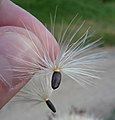Silybum marianum
| Silybum marianum subsp. var. | Blessed Milk Thistle, St Mary's Thistle, Medit. Milk Thistle, Variegated Thistle | |||||||||||||||||||||||||||||||||||||||||||||||||||||||
|---|---|---|---|---|---|---|---|---|---|---|---|---|---|---|---|---|---|---|---|---|---|---|---|---|---|---|---|---|---|---|---|---|---|---|---|---|---|---|---|---|---|---|---|---|---|---|---|---|---|---|---|---|---|---|---|---|

|
|
| ||||||||||||||||||||||||||||||||||||||||||||||||||||||
| ||||||||||||||||||||||||||||||||||||||||||||||||||||||||
Silybum marianum is a milk thistle, is an annual or biennial plant of the Asteraceae family. This fairly typical thistle has red to purple flowers and shiny pale green leaves with white veins. Originally a native of Southern Europe through to Asia, it is now found throughout the world. The medicinal parts of the plant are the ripe seeds.
Common names for this species include blessed milk thistle, Marian Thistle, Mary Thistle, St Mary's Thistle, Mediterranean Milk Thistle and Variegated Thistle.
It grows 40 to 100 cm tall. The stem is grooved and more or less cottony.
The leaves are oblong to lanceolate. They are either wavy loved or pinnated, have spiny edges. They are hairless, shiny green, with milk white veins.
The flower heads are 4 to 5 cm long and wide, of red-purple colour. They flower from June to August.
The bracts are hairless, with triangular, spine-edged appendages, tipped with a stout yellow spine.
The achenes are black, with simple long white pappus, surrounded by a yellow basal ring.[1]
| Standard Cyclopedia of Horticulture |
|---|
|
Silybum marianum, Gaertn. (Carduus Marianus, Linn. Mariana lactea, Groves). St. Mary's, Blessed, or Holy Thistle. Annual or biennial, shining: st. 1-4 ft. high, grooved not winged: lvs. large, with strong spines: heads 1-2 in. diam.; involucral bracts leathery with a spine 1/2 – 3/4 in. long, the outermost mucronate: receptacle fleshy: fls. rose-purple: achenes transversely wrinkled or smooth, black or gray. S. Eu., N. Afr., and Asia, also intro. in many places, including N. Amer.; naturalized on the Pacific coast. CH
|
Cultivation
It is hardy to zone 7 and is not frost tender. It is in leaf all year, in flower from July to September, and the seeds ripen from August to October. The flowers are hermaphrodite (have both male and female organs) and are pollinated by Bees.
The plant prefers light (sandy), medium (loamy) and heavy (clay) soils and requires well-drained soil. The plant prefers acid, neutral and basic (alkaline) soils and can grow in very alkaline soil. It cannot grow in the shade. It requires dry or moist soil. The plant can tolerates strong winds but not maritime exposure.
Succeeds in any well-drained fertile garden soil[1, 200]. Prefers a calcareous soil[12] and a sunny position[200]. Hardy to about -15°c[200]. The blessed thistle is a very ornamental plant that was formerly cultivated as a vegetable crop[1, 61, 238].
Propagation
Plants will often self sow freely[K].
Seed - if sown in situ during March or April, the plant will usually flower in the summer and complete its life cycle in one growing season[K]. The seed can also be sown from May to August when the plant will normally wait until the following year to flower and thus behave as a biennial[K]. The best edible roots should be produced from a May/June sowing, whilst sowing the seed in the spring as well as the summer should ensure a supply of edible leaves all year round[K].
Pests and diseases
Young plants are prone to damage from snails and slugs[200].
Varieties
Gallery
References
- ↑ The Wild Flower Key, ISBN 0-7232-2419-6
- Plants for a Future - source of some creative commons text
- Standard Cyclopedia of Horticulture, by L. H. Bailey, MacMillan Co., 1963
External links
- w:Silybum marianum. Some of the material on this page may be from Wikipedia, under the Creative Commons license.
- Silybum marianum QR Code (Size 50, 100, 200, 500)




